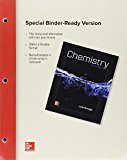
Interpretation:
The number of possible arrangements before and after removal of the central barrier is to be determined and the number of arrangements after the removal of the barriercorresponding to the state in which both molecules are in the left side, right side, and opposite sides of the container, entropy for each state is to be calculated and a comment is to be made on the most probable state of the system after removal of the barrier.
Concept introduction:
The quantity that predicts the spontaneity of a process is called Gibbs free energy. The mathematical equation is as follows:
Here,
Mathematically, entropy by Ludwig Boltzmann is given as follows:
Here,
The number of possible arrangements is given by the equation as follows:
Here,
Want to see the full answer?
Check out a sample textbook solution
Chapter 18 Solutions
Package: Loose Leaf Chemistry with Connect 2-year Access Card
- Actually, the carbon in CO2(g) is thermodynamically unstable with respect to the carbon in calcium carbonate(limestone). Verify this by determining the standardGibbs free energy change for the reaction of lime,CaO(s), with CO2(g) to make CaCO3(s).arrow_forwardConsider a metal ion A2+ and its nitrate salt, In an experiment, 35.00 mL of a 0.217 M solution of A(NO3)2 is made to react with 25.00 mL of 0.195 M NaOH. A precipitate, A(OH)2, forms. Along with the precipitation, the temperature increases from 24.8C to 28.2C. What is H for the precipitation of A(OH)2? The following assumptions can be made. • The density of the solution is 1.00 g/mL. • Volumes are additive. • The specific heat of the solution is 4.18 J/g C.arrow_forwardDescribe a nonchemical system that is not in equilibrium, and explain why equilibrium has not been achieved.arrow_forward
- The standard Gibbs free energy change at 100oC is 18.8 kJ/mol for the solubility equilibrium: Li3PO4(s) →← 3Li+(aq) + PO43–(aq); ∆Gorxn = 18.8 kJ/mol What is the molar solubility of lithium phosphate at this temperature? Enter your answer with correct units and significant figures.arrow_forwardAt 276.7 oC, the Kp for the reaction 2 A (g) + 1 B (g) ↔ 5 AB is Kp = 3.07⋅10-2 What is Keq?arrow_forwardA metal salt with the formula MSO, crystallizes from water to form a solid with the composition MSO, · 5 H,0. At 298 K, the equilibrium vapor pressure of water above this solid is 15.1 Torr. MSO, · 5 H,O(s) = MSO,(s) + 5 H,0(g) What is the value of AG for the reaction when the vapor pressure of water is 15.1 Torr? AG = J/mol What is the value of AG for the reaction at this temperature if the vapor pressure of water is 479 Torr? AG = J/molarrow_forward
- Suggest two ways in which the equilibrium concentration of Ag+ can be reduced in a solution of Na+, Cl−, Ag+, and NO3 −, in contact with solid AgCl.Na+(aq) + Cl−(aq) + Ag+(aq) + NO3−(aq) ⇌ AgCl(s) + Na+(aq) + NO3−(aq)ΔH = −65.9 kJarrow_forwardA reaction has a standard free‑energy change of −18.20 kJ (−4.350 kcal mol−1). Calculate the equilibrium constant for the reaction at 25 °C. Keq =arrow_forwardWhat is ASuniy at 25 °C for the reaction 2 S(s) + Cl2(g) - S2Cl2(g)?arrow_forward
- Calculate AG°ran for the following reaction of white phosphorous with HCl. 2P (s) + 10HC1 (g)→ 2PCI5 (g) + 5H2 (g) AGʻfof P(s) = 0 KJ/mol AG†of HCl (g) = -95.3 KJ/mol AG°fof H2 (g) = 0 KJ/mol AGʻfof PCI5(s) = -305.0 KJ/molarrow_forwardThe equilibrium constant for the reaction Ni2+(aq) + 6 NH3(aq) ⇌ Ni(NH3)6 2+(aq) is Kf = 5.6 × 108 at 25°C. (a) What is ΔG0 at this temperature? (b) If standard-state concentrations of reactants and products are mixed, in which direction does the reaction proceed? (c) Determine ΔG0 when [Ni(NH3)62+] = 0.010 M, [Ni2+] = 0.0010 M, and [NH3] = 0.0050 M.In which direction will the reaction proceed to achieve equilibrium?arrow_forwardHydrogen gas burns in an atmosphere of bromine gas to produce hydrogen bromide gas according to the chemical reaction H, (g) + Br, (g) → 2 HBr(g) Calculate the standard Gibbs free energy of the reaction. Refer to the list of thermodynamic values. AGixn = kJ-mol-! Suppose 130.0 mL of hydrogen gas at STP combines with a stoichiometric amount of bromine gas and the resulting hydrogen bromide dissolves in water to form 185.0 mL of an aqueous solution. What is the concentration of the resulting hydrobromic acid? concentration: Marrow_forward
 Chemistry: The Molecular ScienceChemistryISBN:9781285199047Author:John W. Moore, Conrad L. StanitskiPublisher:Cengage Learning
Chemistry: The Molecular ScienceChemistryISBN:9781285199047Author:John W. Moore, Conrad L. StanitskiPublisher:Cengage Learning General Chemistry - Standalone book (MindTap Cour...ChemistryISBN:9781305580343Author:Steven D. Gammon, Ebbing, Darrell Ebbing, Steven D., Darrell; Gammon, Darrell Ebbing; Steven D. Gammon, Darrell D.; Gammon, Ebbing; Steven D. Gammon; DarrellPublisher:Cengage Learning
General Chemistry - Standalone book (MindTap Cour...ChemistryISBN:9781305580343Author:Steven D. Gammon, Ebbing, Darrell Ebbing, Steven D., Darrell; Gammon, Darrell Ebbing; Steven D. Gammon, Darrell D.; Gammon, Ebbing; Steven D. Gammon; DarrellPublisher:Cengage Learning Chemistry: Principles and ReactionsChemistryISBN:9781305079373Author:William L. Masterton, Cecile N. HurleyPublisher:Cengage Learning
Chemistry: Principles and ReactionsChemistryISBN:9781305079373Author:William L. Masterton, Cecile N. HurleyPublisher:Cengage Learning Principles of Modern ChemistryChemistryISBN:9781305079113Author:David W. Oxtoby, H. Pat Gillis, Laurie J. ButlerPublisher:Cengage Learning
Principles of Modern ChemistryChemistryISBN:9781305079113Author:David W. Oxtoby, H. Pat Gillis, Laurie J. ButlerPublisher:Cengage Learning Chemistry: Principles and PracticeChemistryISBN:9780534420123Author:Daniel L. Reger, Scott R. Goode, David W. Ball, Edward MercerPublisher:Cengage Learning
Chemistry: Principles and PracticeChemistryISBN:9780534420123Author:Daniel L. Reger, Scott R. Goode, David W. Ball, Edward MercerPublisher:Cengage Learning




